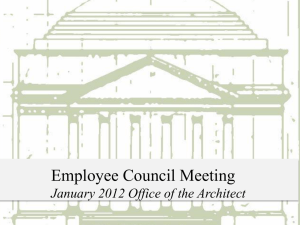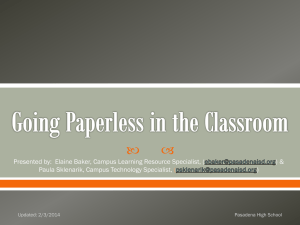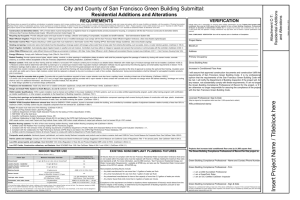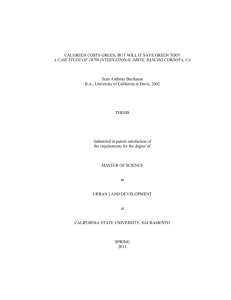Adoption of the 2010 California Green Building
advertisement
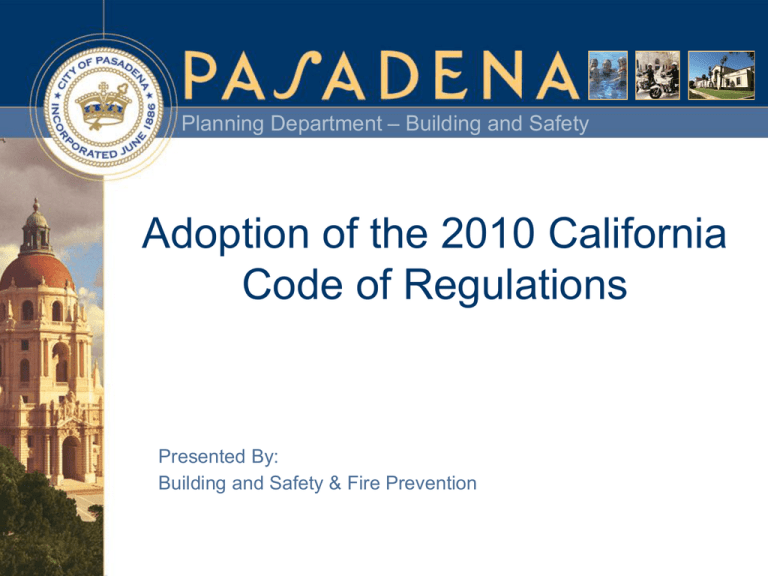
Planning Department – Building and Safety Adoption of the 2010 California Code of Regulations Presented By: Building and Safety & Fire Prevention Overview Planning Department – Building and Safety • • • • Statement of Intent Highlights of Each Code’s Amendments General Adoption Timeline Training and Outreach Statement of Intent Planning Department – Building and Safety • Adopt and amend where necessary the latest California Code of Regulations (also known as Title 24) as part of a triennial statewide code adoption cycle. This includes: > > > > > > > > > > • Part 1: Part 2: Part 2.5: Part 3: Part 4: Part 5: Part 6: Part 9: Part 11: Part 12: 2010 California Administrative Code 2010 California Building Code 2010 California Residential Code (All new) 2010 California Electrical Code 2010 California Mechanical Code 2010 California Plumbing Code 2010 California Energy Code 2010 California Fire Code 2010 California Green Building Standards Code (All new) 2010 California Referenced Standards Amend the Pasadena Municipal Code (PMC) Title 14 relating to Building and Construction to reference these new codes and their respective amendments. Statement of Intent (cont.) Planning Department – Building and Safety • • • Repeal the existing Pasadena Green Buildings Ordinance and replace it with the locally amended 2010 California Green Building Standards Code (also known as CALGreen) to be in compliance with the statewide adoption of this code. Ensure that these new codes and standards are as effective, if not more so, as our existing ordinances in meeting Pasadena’s fire and life safety and environmental concerns for development. Accelerate the reach of City’s fire and life safety, water and energy conservation goals without being overly burdensome on a single sector of the development community. Adoption Guidelines Planning Department – Building and Safety • • • • California Code of Regulations automatically becomes effective January 1, 2011. Local jurisdictions must adopt and enforce these newly adopted codes as-is or amend them to local conditions. Local jurisdictions may add to or amend these state codes to be more restrictive, but not less restrictive. Local amendments can only be justified by findings based on local geologic, topographic, climatic, and, in the case of the California Green Building Standards Code, environmental conditions. Building Code Highlights Planning Department – Building and Safety • Most of previous amendments are carried through unchanged from the previous code cycle. > • High Fire Hazard Area Amendments > • Exception: Newly introduce code provisions. Previous amendments absorbed into code. staff is recommending language to clarify that Chapter 7A, Materials and Construction Methods for Exterior Wildfire Exposure, applies to additions and alterations as well as new construction. Structural Amendments > Adopted by most cities throughout the Los Angeles Basin. Residential Code Highlights Planning Department – Building and Safety • • • • • Consolidates the provisions from various sections of the Building Code into one separate and distinct code. Mandatory fire sprinkler system in all newly constructed one, two-family dwellings, and townhomes. This was previously required only for residential buildings of three units or more. Limit prescriptive design standards to one story construction instead of up to three stories. No wood foundations. Prohibit the use of staples for wood frame construction. Fire Code Highlights Planning Department – Building and Safety • • • • Most of previous amendments are carried through unchanged from the previous code cycle. > Exception: Newly introduce code provisions. Previous amendments absorbed into code. International Wildland-Urban Interface Code, 2009 Edition, as the adopted reference standard. Adoption of California State Fire Marshal guidelines for the installation of photovoltaic systems. Changes to the existing requirements for upgrading fire sprinkler, fire alarm and in-building public safety radio coverage to include required to upgrade when an additional level is created or total floor area is expanded by 50%. CALGreen and Pasadena’s Green Building Program Planning Department – Building and Safety CALGreen Pasadena Green Building Program Effective Date January 1, 2011 (July 1, 2011 for water efficiency) April 2006 Basis CALGreen Standards Leadership in Energy and Environmental Design (LEED) Green Building Rating System Documentation City of Pasadena Plan Review US Green Building Council (USGBC) template staging. Consultant review Field Verification Mandatory City Inspection Personnel w/ third party commissioning where needed Optional third party verification. Applicability All residential and nonresidential new buildings and additions and alterations to existing buildings Mixed use and multi-family residential buildings 4 stories and more. Non-residential > 25,000 sq. ft.. Municipal buildings > 5,000 sq. ft. CALGreen and Pasadena’s Green Building Program (cont.) Planning Department – Building and Safety CALGreen Pasadena Green Building Program Updates and Revisions for new technologies Every three years with the adoption of the California Code of Regulations No regular schedule Documentation Review and Approval Qualified City staff Certified LEED accredited professionals Minimum Equivalent Compliance Levels Un-amended Tier 1 = 27 LEED points Un-amended Tier 2 = 40 LEED points LEED Certified = 40 - 49 points LEED Silver = 50 – 59 points Applicability of Green Building Standards Planning Department – Building and Safety Building Permits Since 2006 0% 4% Green Buildings Program New Buildings Additions and Alterations** **Permits for non-building related projects excluded. 96% General Adoption Timeline Planning Department – Building and Safety • • • • • • • • • October 19th – Environmental Advisory Committee October 21st – Public Safety Committee October 25th – City Council to direct City Attorney to prepare an ordinance. November 8th – First Reading of the Ordinance November 15th – Second Reading of the Ordinance Beginning November – Staff General Training Beginning December – Public information meetings January 1st – Ordinance becomes effective Mid January –Detailed Staff Training Planning Department – Building and Safety Questions




